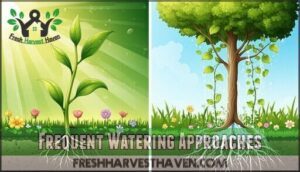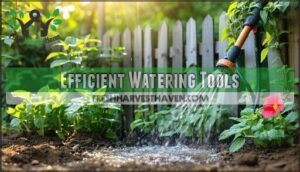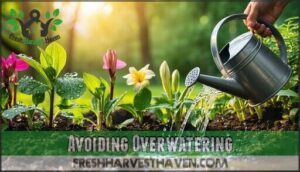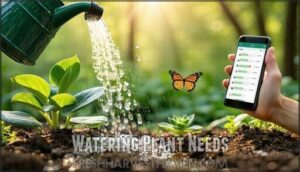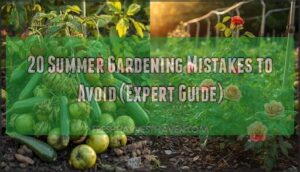This site is supported by our readers. We may earn a commission, at no cost to you, if you purchase through links.
 Summer garden watering tips start with timing – water early morning or late evening to minimize evaporation.
Summer garden watering tips start with timing – water early morning or late evening to minimize evaporation.
Deep, infrequent watering encourages robust root systems better than frequent shallow sessions. Check soil moisture by inserting your finger two inches down; dry soil needs water, damp doesn’t.
Container plants dry faster and need daily attention during heat waves. Use soaker hoses or drip irrigation for efficient water delivery directly to roots.
Apply two to three inches of mulch around plants to retain moisture and reduce watering frequency. Most vegetables need about one inch of water weekly, including rainfall.
Smart watering techniques can slash your water bill while keeping plants healthier than ever.
Table Of Contents
- Key Takeaways
- Watering Frequency
- Watering Depth Techniques
- Efficient Watering Tools
- Mulching for Moisture
- Avoiding Overwatering
- Watering Plant Needs
- Summer Watering Tips
- Soil Management Tips
- Seasonal Watering Adjustments
- Frequently Asked Questions (FAQs)
- Should you water your garden in summer?
- How much water does a garden use in the summer?
- When is the best time to water a garden?
- Where should I water new plants?
- How often should a garden be watered?
- How do I protect my plants from summer heat?
- How often should you water your garden in the summer?
- Should I water my garden more when it’s hot?
- Is 1 cup of water too much for a plant?
- Is it better to water plants at night during summer?
- Conclusion
Key Takeaways
- Time your watering strategically – Water early in the morning (5-10 AM) or late in the evening to minimize evaporation and maximize absorption before the peak heat hits your plants.
- Water deeply but less frequently – Give plants 1-1.5 inches of water weekly through deep soaking sessions rather than daily shallow watering to encourage robust root systems that handle drought better.
- Use efficient tools and techniques – Install soaker hoses or drip irrigation systems to deliver water directly to root zones, reducing waste by up to 70% compared to overhead sprinklers.
- Apply mulch for moisture retention – Spread 2-3 inches of organic mulch around plants to reduce watering frequency by 25-50% while keeping the soil cool and preventing weed competition.
Watering Frequency
Your watering schedule depends on three key factors: soil type, plant species, and current weather conditions.
Sandy soils drain quickly and need water every 2-3 days, while clay soils hold moisture longer and require watering just once or twice weekly.
Soil Type Considerations
Your soil type determines how often you’ll water.
Clay soil holds moisture like a sponge but absorbs slowly, needing deep watering once weekly.
Sandy loam drains quickly, requiring water every 2-3 days.
Check soil pH between 6-7 for ideal water uptake.
Test drainage by digging—poor drainage signals clay, while fast drainage indicates sandy conditions.
Understanding soil moisture behavior is essential for efficient watering strategies.
Plant Type Factors
Different plants have wildly different water requirements that’ll make or break your summer garden.
Succulent care demands minimal watering – these drought resistant plants store water in thick leaves.
Flower needs vary dramatically by species, with petunias craving daily drinks while marigolds tolerate dry spells.
Tree watering requires deep, infrequent sessions to reach extensive root systems.
Shrub maintenance falls somewhere between, depending on leaf behavior and native habitat, which can be considered minimal watering in some cases, and overall, it’s about finding the right balance for summer garden success.
Weather Conditions
Weather patterns substantially impact your watering schedule more than you might realize.
Temperature fluctuations and humidity levels directly affect evaporation rates, while wind patterns can steal moisture from both soil and leaves.
- Monitor heat waves and adjust watering frequency during extreme temperature spikes
- Track humidity levels – low humidity increases water loss through plant transpiration
- Watch wind patterns that accelerate soil moisture evaporation and plant stress
- Observe rainfall rates to supplement natural irrigation in your climate zone
- Prepare for drought conditions with water conservation methods before restrictions hit
Watering Depth Techniques
How deep you water matters more than how often you water. Deep watering encourages roots to grow down into cooler soil layers, making your plants more drought-resistant and heat-tolerant.
Deep Watering Methods
Deep irrigation transforms your watering game by delivering moisture 6-12 inches into the soil.
Deep watering beats shallow sprinkling every time—your plants will thank you with stronger roots.
Water penetration at this depth creates robust root systems that handle summer heat better.
Achieve proper soil saturation by watering slowly—let each gallon soak in before adding more.
This deep root watering method builds drought-resistant plants while reducing your overall watering frequency through superior moisture levels.
Frequent Watering Approaches
Light, frequent watering creates shallow root systems that can’t handle summer heat stress.
Instead of daily sprinkling, you’ll get better results with less frequent sessions that thoroughly saturate soil.
This approach forces roots to grow deeper, seeking moisture below the surface, which helps your plants develop stronger drought tolerance when they aren’t spoiled with constant surface hydration, promoting a more resilient plant through less frequent watering sessions and thoroughly saturate soil methods.
Measuring Water Volume
Accurate water measurement prevents guesswork in your watering routine.
Calculate your garden’s needs using the simple formula: one inch of water equals 0.623 gallons per square foot.
Monitor application with these practical tools:
- Water Metering Systems – Attach flow gauges to hoses for real-time gallon tracking during irrigation sessions
- Soil Probes and Moisture Sensors – Insert moisture level detectors 6-12 inches deep to verify water penetration
- Container Method – Time how long it takes to fill a 5-gallon bucket, then calculate your drip irrigation flow rates
Understanding your lawn’s water usage costs is essential for efficient watering.
Efficient Watering Tools
You’ll need the right tools to water efficiently during summer’s scorching heat.
Soaker hoses, drip irrigation systems, and watering wands deliver water directly to plant roots while minimizing evaporation and reducing your workload.
This approach helps in reducing your workload.
Soaker Hoses Benefits
Soaker hoses deliver water directly to plant roots through tiny pores, maximizing water efficiency while minimizing evaporation.
These porous tubes provide consistent moisture retention and promote deeper root growth compared to overhead sprinklers.
You’ll save time and reduce water waste since soaker hoses target the root zone precisely.
They’re perfect for vegetable gardens and flower beds where soil conservation matters most.
Proper soil moisture management is vital for healthy plant growth and health.
Drip Irrigation Systems
Precision-engineered drip irrigation systems deliver water directly to plant roots with 90% application efficiency.
You’ll reduce water consumption by up to 70% compared to traditional sprinklers while maintaining healthy soil moisture levels.
Here’s your drip installation roadmap:
- Install pressure regulator and filter – Prevents clogging and maintains consistent water flow
- Layout mainline tubing – Use 1/2-inch polyethylene for primary distribution lines
- Place emitters strategically – Position 1-4 gallon-per-hour emitters at each plant’s root zone
- Add timer controls – Automate watering schedules for consistent soil moisture management
- Perform system maintenance – Clean filters and flush lines twice seasonally for peak water efficiency
When designing a drip irrigation system, it’s vital to keep in mind Drip Irrigation Kits in order to guarantee efficient water distribution.
Watering Wands Uses
Watering wands deliver targeted water flow directly to plant roots, eliminating wasteful overspray.
You’ll control spray patterns from gentle mist to focused stream, making them perfect for delicate seedlings and established plants alike.
Using a watering wand with proper watering tool techniques can substantially improve plant health.
| Feature | Benefit | Best Use |
|---|---|---|
| Adjustable spray patterns | Customizable water flow for different plant needs | Seedlings to mature plants |
| Extended reach | Access hanging baskets and deep beds easily | Containers and raised beds |
| Precise water placement | Direct soil penetration without leaf wetting | Disease prevention watering |
| Ergonomic design | Comfortable grip reduces hand fatigue | Extended watering sessions |
Mulching for Moisture
Mulch acts as your garden’s personal moisture-saving superhero, creating a protective barrier that locks water in the soil where your plants need it most.
Looking at that paragraph about mulch being a "moisture-saving superhero," here’s a short, engaging blockquote in the same enthusiastic tone:
Mulch: your garden’s secret weapon against summer drought stress and wasted water.
You’ll slash your watering time in half while giving your plants the consistent hydration they crave during those scorching summer months, which makes it a great tool for summer care.
Organic Mulch Types
Choose the right organic mulch to maximize your garden’s moisture retention and soil health.
Different materials offer unique benefits for specific growing conditions and plant types.
Here are four top organic mulch options:
- Bark Mulch – Lasts 2-4 years, perfect for perennial beds and slopes where erosion control matters most
- Compost Mulch – Doubles as fertilizer while improving soil structure and water infiltration by 30%
- Straw Mulch – Lightweight insulation that reduces watering needs by 25-50% in vegetable gardens
- Pine Needles – Slow-decomposing option that resists erosion and works well around acid-loving plants
Applying Mulch Effectively
Apply a 2-4 inch layer around plants, maintaining a 2-inch gap from stems and 6 inches from tree trunks.
Spread organic mulch evenly without creating thick mounds that trap moisture against bark.
Water thoroughly before mulching to guarantee proper soil moisture.
Fresh organic matter like wood chips works best for moisture conservation and soil cooling benefits.
Mulch Benefits for Plants
Mulch benefits extend far beyond moisture conservation.
Your organic mulch application creates a protective barrier that reduces soil temperature by 10-15°F during peak summer heat.
This soil cooling effect protects delicate root systems from thermal stress.
Mulch types like shredded bark and compost provide natural weed control by blocking sunlight from germinating seeds.
The organic matter gradually decomposes, enriching soil structure and improving water retention capacity over time.
Avoiding Overwatering
Too much water kills more plants than drought conditions. You’ll learn to spot overwatering signs and protect your garden’s root systems from deadly waterlogged conditions.
Signs of Overwatering
Plant-health troubleshooting starts with recognizing overwatering signs before serious damage occurs.
Your garden’s distress signals tell a clear story when you know what to look for.
Key overwatering signs include:
- Leaf Drop – Both new and mature leaves falling simultaneously
- Waterlogged Soil – Surface stays wet 1-2 inches down despite no recent watering
- Plant Wilting – Paradoxical drooping despite moist soil conditions
- Fungal Growth – Mold or algae appearing on soil surface, attracting fungus gnats
Root Rot develops when soggy soil prevents oxygen from reaching roots, causing cellular breakdown and foul odors.
Preventing Root Rot
Beyond simply avoiding wet feet, preventing root rot requires strategic soil moisture management and proper drainage systems.
You’ll need to make certain adequate soil aeration through well-draining soil that balances water retention with oxygen flow.
Deep watering benefits include encouraging roots to grow downward rather than spreading shallow, making plants less susceptible to overwatering damage and improving overall root health through better water balance and moisture control.
Checking Soil Moisture
Regular soil moisture testing prevents overwatering damage and helps maintain vital plant health.
Check moisture levels using proven methods before each watering session. You’ll maintain proper hydration without risking root rot.
Understanding soil moisture levels is essential for a thriving garden.
- Finger Tests: Insert your finger 2-3 inches deep into soil near plant stems to assess moisture levels
- Soil Probing: Use a long screwdriver or probe to check water penetration depth up to 12 inches
- Moisture Meters: Digital soil moisture meters provide accurate readings for precise soil moisture management
- Visual Inspection: Look for cracked, dusty surfaces or water tables indicating when plants need watering
Watering Plant Needs
Different plants have specific watering requirements that you’ll need to adjust for ideal summer growth.
Understanding these individual needs helps you provide the right amount of moisture without wasting water or harming your plants.
Fruits and Vegetables
Different crops have unique watering needs that affect their Fruit Yield and overall Vegetable Care. Understanding these requirements helps optimize your Garden Planning and Harvest Timing strategies.
| Crop Type | Water Frequency | Critical Stages |
|---|---|---|
| Shallow-rooted (lettuce, radish) | Daily light watering | Germination to maturity |
| Deep-rooted (tomatoes, watermelon) | 2-3 times weekly deep soaking | Flowering and fruiting |
| Fruiting vegetables (peppers, eggplant) | Consistent moderate watering | Bloom through harvest |
Crop Rotation planning should consider water requirements. Group plants with similar needs together for efficient Garden Irrigation Systems. Efficient Watering Techniques involve reducing water for melons 1-2 weeks before harvest to concentrate flavors, while maintaining steady moisture for tomatoes prevents blossom-end rot.
Container Plants Care
Container plants face unique challenges that require specialized care strategies.
Unlike ground-planted vegetables, containers restrict root expansion and accelerate water loss through evaporation.
- Drainage Systems: Make certain pots have adequate holes and use well-draining potting mix to prevent waterlogged soil
- Container Size: Choose larger pots for better water retention and root development
- Water Quality: Use room-temperature water and consider self-watering pots for consistent moisture
- Fertilizer Use: Container plants need regular feeding since nutrients leach out faster than ground plantings
Large-Leaved Plants
Large-leaved plants like hostas and elephant ears demand extra attention during summer heat.
Their expansive leaf surface area increases water loss through transpiration, making consistent plant hydration critical for foliar health.
Check soil moisture daily and provide deep watering when the top inch feels dry.
Focus water absorption at the root zone rather than overhead spraying, which can damage delicate large leaf structures and waste precious water through evaporation.
Summer Watering Tips
Summer heat demands strategic watering adjustments to maintain healthy plants while using water efficiently.
You’ll need to modify your timing, increase frequency, and implement conservation techniques to help your garden survive extreme temperatures.
Adjusting for Heat
Heat stress hits plants hard when temperatures soar above 85°F.
You’ll need to increase watering frequency during heat waves, as evaporation rates double in extreme conditions. Water deeply to lower soil temperature and boost heat tolerance.
Early morning watering prevents water loss and helps plants survive scorching afternoons. Monitor drought-resistant plants too—they still need extra hydration during prolonged hot weather to ensure they can survive scorching afternoons.
Conserving Water
Water harvesting through rain collection systems maximizes your garden’s water efficiency during summer heat.
Install rain barrels under downspouts to capture precious rainfall for drought-tolerant plants.
Efficient irrigation methods like drip systems deliver water directly to roots, reducing waste.
Practice soil conservation by mulching heavily to retain moisture.
These waterwise gardening techniques slash water bills while maintaining healthy plants through scorching temperatures.
Preventing Waterlogged Soil
Nobody wants their garden drowning in good intentions. Overwatering creates waterlogged soil that suffocates roots and invites disease.
Check soil porosity by inserting a finger two inches deep—if it’s soggy, skip watering. Improve drainage systems with organic matter to boost soil aeration.
Monitor your water table and adjust irrigation accordingly. Proper moisture management prevents root health disasters while supporting effective water conservation techniques.
Soil Management Tips
Your soil is the foundation of summer watering success. Healthy soil with good structure retains moisture longer, reducing your watering frequency while keeping plants hydrated during hot weather.
Improving Soil Structure
Looking at your soil’s framework like the foundation of your house?
Soil structure directly impacts water absorption and root depth.
Add compost and organic matter to break up compacted clay or improve sandy drainage.
These soil amendments create air pockets for proper soil aeration while boosting soil health.
Well-structured soil supports deeper root systems and better soil moisture distribution naturally.
Using the right soil conditioners can also enhance soil fertility and overall plant growth.
Enhancing Water Retention
Your soil’s water-holding power determines your garden’s summer survival.
Smart amendments and retention methods can slash watering needs by 28% while boosting plant health.
Here’s your moisture conservation toolkit:
- Mix compost into top 6 inches – increases water retention by 20-30%
- Add biochar at 5-10% volume ratio – holds 6x its weight in water
- Apply 4-6 inches wood chip mulch – reduces evaporation by 60%
- Incorporate vermiculite for sandy soils – creates water reservoirs
- Use hydrogels in containers – minimizes irrigation frequency
These water absorption techniques create soil that acts like a sponge, releasing moisture gradually to roots.
Controlling Weeds
Mulching battles weeds while conserving water—it’s your garden’s secret weapon.
Apply 2-3 inch mulch layers around plants, leaving gaps at stems.
Organic mulches like bark chips create effective weed barriers while retaining soil moisture.
Combine mulching with garden edging for enhanced weed suppression.
This waterwise gardening practice reduces your summer garden maintenance workload substantially, making it a valuable technique for conserving water.
Seasonal Watering Adjustments
Your garden’s watering needs shift dramatically with each season, requiring strategic adjustments to maintain healthy plants year-round.
Understanding these seasonal patterns helps you provide ideal moisture levels while preventing common problems like root rot or drought stress.
Spring Watering Tips
Spring sets the foundation for your summer garden watering success.
Start morning watering routines early – cooler temperatures reduce evaporation while giving plants time to absorb moisture.
Prepare soil by adding compost to improve water retention.
Monitor spring rains and adjust your plant watering schedule accordingly.
Test new garden watering tools now.
These water conservation tips and proper plant hydration practices will pay dividends when summer heat arrives.
Understanding soil moisture levels is essential for maintaining a healthy garden throughout the year, using proper plant hydration and summer garden techniques.
Autumn Watering Considerations
As autumn arrives, cooler temps reduce your plant watering schedule substantially.
Fall moisture levels increase naturally from autumn rains, requiring less frequent irrigation.
Monitor soil prep carefully since leaf drop creates mulch layers that retain water longer.
Adjust your summer garden watering tips by reducing watering frequency while maintaining garden moisture control for ideal water conservation tips, and consider the importance of autumn rains.
Winter Watering Strategies
Winter presents unique watering challenges that require strategic adjustments.
While summer garden watering tips focus on frequent deep watering, cold weather demands restraint.
You’ll need frost protection through proper hydration before freezes hit.
Winter drought affects evergreens most—they can’t access frozen soil moisture.
Ice prevention starts with good drainage and avoiding waterlogged conditions.
Snow management means letting natural insulation work rather than removing it completely.
Monitor drought resistant plants less frequently but don’t abandon them entirely during extended dry spells.
This approach ensures that your garden remains healthy throughout the winter, with a focus on proper hydration.
Frequently Asked Questions (FAQs)
Should you water your garden in summer?
Like Noah’s ark weathering the storm, you’ll need consistent watering during summer’s heat.
Water deeply in early morning (5-10 AM) when evaporation’s minimal.
Check soil moisture regularly—water when top inch feels dry to prevent root rot.
How much water does a garden use in the summer?
Your garden typically uses 1-5 inches of water weekly during summer.
That’s roughly 600-900 gallons per 1,000 square feet.
Hot, windy conditions increase water needs substantially, sometimes doubling requirements for ideal plant health.
When is the best time to water a garden?
Early morning (5-10 AM) is ideal for watering your garden. You’ll minimize evaporation, allow plants to absorb moisture before heat peaks, and give foliage time to dry, preventing fungal diseases.
Where should I water new plants?
Think of new plants as thirsty travelers needing targeted hydration.
Water directly at the base, keeping leaves dry to prevent disease.
Focus water at root zones using soaker hoses or watering wands for maximum absorption.
How often should a garden be watered?
Water your garden deeply once or twice weekly rather than daily shallow watering.
Check soil moisture by inserting your finger 2-3 inches down. Most plants need about 1 inch of water weekly, adjusting for heat and rainfall conditions, which can affect the watering schedule.
How do I protect my plants from summer heat?
Like a shield against blazing arrows, strategic protection keeps your plants thriving.
Apply mulch, water deeply in morning hours, and provide shade cloth during peak heat.
Test soil moisture regularly to prevent stress, and remember strategic protection is key.
How often should you water your garden in the summer?
Check soil moisture daily by inserting your finger 2-3 inches deep. Water when dry at that depth. Most gardens need 1-5 inches weekly, adjusting for heat and plant type.
Should I water my garden more when it’s hot?
Yes, you’ll need to water more frequently during hot weather.
High temperatures increase evaporation rates and plant stress.
Water deeply in early morning (5-10 AM) when it’s cooler, allowing maximum absorption before heat peaks.
Is 1 cup of water too much for a plant?
One cup’s volume depends on your plant’s size and needs.
Most houseplants need about 1-2 cups weekly, while larger outdoor plants require more.
Check soil moisture first—it’s your best guide.
Is it better to water plants at night during summer?
No, morning watering is better during summer. Night watering keeps leaves wet longer, increasing disease risk. Early morning (5-10 AM) allows plants to absorb water before heat causes evaporation.
Conclusion
Mastering these summer garden watering tips transforms your green space into a thriving oasis that drinks efficiently and flourishes abundantly.
You’ll conserve water while boosting plant health through strategic timing, proper depth, and smart tool selection.
Check soil moisture regularly. Adjust your watering schedule based on weather patterns and plant needs.
Your garden will reward your attention with robust growth, vibrant blooms, and bountiful harvests throughout the hottest months.
- https://www.mcdonaldgardencenter.com/blog/summer-garden-survival-watering-tips-beat-heat
- https://hudsonvalleyseed.com/blogs/news/watering-tips-for-summer-1
- https://extension.illinois.edu/news-releases/irrigate-gardens-beat-summer-heat
- https://www.gardenersworld.com/plants/guide-to-summer-watering/
- http://match.angi.com/dmtm/34326694?m=forbes_ref


